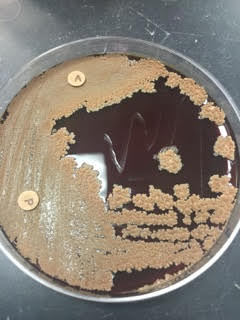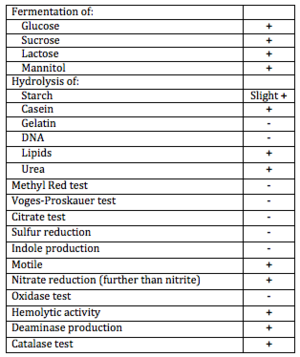Microorganism Bacillus licheniformis: Difference between revisions
Erin.collins (talk | contribs) |
Erin.collins (talk | contribs) |
||
| Line 49: | Line 49: | ||
[[Image: | [[Image:Differential_Biochemical_Tests2.png|thumb|''Differential Test Results for B. licheniformis'']] | ||
closely related to Bacillus subtilis | closely related to Bacillus subtilis | ||
Revision as of 03:21, 4 December 2015
Classification
Domain: Bacteria; Phylum: Firmicutes; Class: Bacilli; Order: Bacillales; family: Bacillaceae; Genus: Bacillus;
Species
|
NCBI: Taxonomy |
Bacillus licheniformis
Habitat Information
Bacillus licheniformis is found in soil. It is often found on feathers of ground-dwelling and aquatic species of birds.
Description and Significance
Describe the appearance (colonial and cellular), possible antimicrobial activity etc. of the organism, and why the organism might be significant.
B. licheniformis is a rod-shaped, gram positive motile bacterium. It is spore-forming under harsh conditions and closely related to the widely studied B. subtilis. Unlike other bacilli which are predominately aerobic, B. licheniformis is a facultative anaerobe, which explains it's ability to grow in additional ecological niches and environments.
Colonies are both round and irregular in shape, with irregular (undulate, fimbriate) margins. The surface of B. licheniformis colonies are often rough and wrinkled, with "licheniform", or hair-like growths. Color ranges from opaque to white.
B. licheniformis exhibits antimicrobial activity against both E. coli and S. aureus. It is also resistant to some commonly used antibiotics, including bacitracin, oxacillin and nafcillin.
Genome Structure
Describe the size and content of the genome. How many chromosomes? Circular or linear? Other interesting features? What is known about its sequence? Include S Ribosomal sequence that you obtained from PCR and sequencing here.
NEEDS TO BE REWRITTEN
We determined the complete nucleotide sequence of the B. licheniformis ATCC 14580 genome which comprises a circular chromosome of 4,222,336 base-pairs (bp) containing 4,208 predicted protein-coding genes with an average size of 873 bp, seven rRNA operons, and 72 tRNA genes. The B. licheniformis chromosome contains large regions that are colinear with the genomes of B. subtilis and Bacillus halodurans, and approximately 80% of the predicted B. licheniformis coding sequences have B. subtilis orthologs.
Cell Structure, Metabolism and Life Cycle
Interesting features of cell structure; how it gains energy; what important molecules it produces.
gram +, spore forming
Physiology and Pathogenesis
Biochemical characteristics, enzymes made, other characteristics that may be used to identify the organism; contributions to environment (if any).
If relevant, how does this organism cause disease? Human, animal, plant hosts? Virulence factors, as well as patient symptoms.
closely related to Bacillus subtilis facultative anaerobe,
NEEDS TO BE REWRITTEN
There are numerous commercial and agricultural uses for B. licheniformis and its extracellular products. The species has been used for decades in the manufacture of industrial enzymes including several proteases, α-amylase, penicillinase, pentosanase, cycloglucosyltransferase, β-mannanase and several pectinolytic enzymes. The proteases from B. licheniformis are used in the detergent industry as well as for dehairing and bating of leather [2,3]. Amylases from B. licheniformis are deployed for the hydrolysis of starch, desizing of textiles and sizing of paper [3]. Specific B. licheniformis strains are also used to produce peptide antibiotics such as bacitracin and proticin in addition to a number of specialty chemicals such as citric acid, inosine, inosinic acid and poly-γ-glutamic acid [4]. Some B. licheniformis isolates can mitigate the affects of fungal pathogens on maize, grasses and vegetable crops [5]. As an endospore-forming bacterium, the ability of the organism to survive under unfavorable environmental conditions may enhance its potential as a natural biocontrol agent.
Applications
Scientists at Newcastle University have been researching how the organism's ability to release an enzyme that breaks down external DNA may aid in breakdown of dental biofilms, or plaque. Lab tests have confirmed the enzyme's ability to break up and remove bacteria present in plaque, and thus prevent the build up of plaque[2].
References
(2) Wilkinson, Tom (4 July 4 2012). "Seaweed could fight tooth decay – scientists". Independent.ie.
Author
Page authored by Clarissa Alejando and Erin Collins, students of Prof. Kristine Hollingsworth at Austin Community College.


